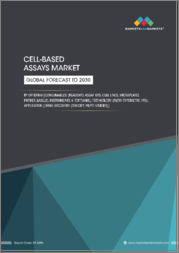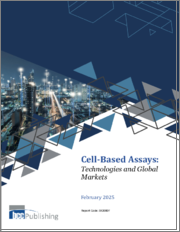
|
시장보고서
상품코드
1660684
세포 기반 어세이 시장 보고서 : 제품 및 서비스별, 기술별, 용도별, 최종사용자별, 지역별(2025-2033년)Cell-based Assay Market Report by Product and Services, Technology, Application, End-User, and Region 2025-2033 |
||||||
세포 기반 어세이 세계 시장 규모는 2024년 241억 달러에 달했습니다. 향후 IMARC Group은 2033년까지 시장 규모가 452억 달러에 달할 것으로 예상하며, 2025년부터 2033년까지 6.88%의 연평균 성장률(CAGR)을 기록할 것으로 전망하고 있습니다. 다양한 질병에 대응하기 위한 새로운 치료법에 대한 수요 증가, 맞춤형 의료에 대한 관심 증가, 약물 스크리닝의 정확성을 향상시키기 위한 세포배양 기술의 혁신 등이 시장을 이끄는 주요 요인 중 일부입니다.
세포 기반 어세이(세포 어세이라고도 함)은 특정 물질이나 조건에 반응하는 세포의 생물학적 활성을 평가하기 위해 다양한 과학 및 의료 분야에서 사용되는 실험 기술입니다. 통제된 환경에서 살아있는 세포를 배양하고 약물, 화합물, 환경 요인 등 다양한 자극에 노출시키는 것으로 이루어집니다. 세포의 생존율, 특정 바이오마커의 발현 등 세포의 거동 변화를 모니터링함으로써 연구자들은 시험물질이 세포 기능에 미치는 영향에 대한 중요한 인사이트를 얻을 수 있기 때문에 세포 기반 어세이에 대한 수요가 전 세계적으로 증가하고 있습니다.
현재, 신약 개발, 독성학 연구, 질병 모델링, 세포 기전 규명 등을 위해 세포 기반 어세이의 채택이 증가하고 있으며, 이는 시장 성장을 뒷받침하고 있습니다. 이와 더불어, 제약 화합물의 잠재적 효능과 안전성을 평가하고자 하는 요구가 증가하면서 시장 성장을 강화하고 있습니다. 또한, 연구자들이 시장 개발 초기 단계에서 잠재적인 부작용을 식별하고 화학제품의 독성을 평가할 수 있는 세포 기반 어세이에 대한 수요가 증가함에 따라 시장에 긍정적인 영향을 미치고 있습니다. 이와는 별도로 암, 당뇨병, 자가면역질환과 같은 만성질환이 전 세계적으로 증가하고 있는 것도 업계 투자자들에게 유리한 성장 기회를 제공하고 있습니다. 또한, 화학제품과 오염 물질이 식물과 수생 시스템에 미치는 영향을 평가할 필요성이 증가함에 따라 시장 성장을 촉진하고 있습니다.
세포 기반 어세이 시장 동향/촉진요인:
다양한 질병을 치료할 수 있는 새로운 치료법에 대한 수요 증가
신약 개발 및 약물 개발에 대한 관심이 높아지면서 전 세계 개인의 다양한 만성질환을 치료할 수 있는 새로운 치료법에 대한 수요가 증가하면서 시장 성장에 기여하고 있습니다. 또한, 세포 기반 어세이를 통해 연구자들은 수많은 잠재적 약물 후보물질을 신속하고 효율적으로 스크리닝하고 평가할 수 있습니다. 세포를 다양한 화합물에 노출시킴으로써 과학자들은 유효성 및 안전성 프로파일과 같은 세포의 행동에 미치는 영향을 평가할 수 있습니다. 이와는 별도로, 약물이 특정 세포 경로와 상호 작용하는 방식을 깊이 이해해야 하는 정밀 의학에 대한 관심이 높아지고 있습니다. 또한, 이러한 분석은 개별 환자의 프로필에 맞게 약물 치료를 조정할 수 있는 플랫폼을 제공합니다.
맞춤형 의료에 대한 관심 증가
맞춤형 의약품에 대한 대중의 관심이 높아지면서 시장 성장을 견인하고 있습니다. 이에 따라 의료 기관들은 개별 환자의 유전적, 분자적, 세포적 특성에 맞는 맞춤형 치료 솔루션에 빠르게 주목하고 있습니다. 이와 더불어, 세포 기반 어세이를 통해 연구자들은 다양한 약물 및 치료에 대한 환자 유래 세포의 반응을 평가하여 잠재적인 부작용을 최소화하면서 가장 효과적인 치료법을 찾아낼 수 있습니다. 또한, 맞춤형 의료는 치료 결과를 개선할 뿐만 아니라 비효율적인 치료를 피함으로써 의료 비용을 절감할 수 있습니다. 그 결과, 임상과 연구 모두에서 세포 기반 어세이의 채택이 증가하고 있습니다. 세포 기반 어세이는 의료 개입을 환자의 특정 요구에 맞게 조정할 수 있는 강력한 도구이기 때문입니다.
세포배양 기술 혁신
세포배양 기술의 발전은 세포 기반 어세이의 능력을 향상시키고 있으며, 3D 배양 및 오가노이드는 연구자들이 인체에 더 가까운 세포 거동을 연구하고 약물 스크리닝 및 독성 테스트의 정확성을 향상시킬 수 있도록 돕고 있습니다. 또한, 마이크로플루이드와 랩온칩 기술은 소형화 및 자동화된 세포 기반 어세이법을 개발할 수 있게 하여 신약 개발의 처리량 및 효율성을 향상시키는 데 기여하고 있습니다. 이에 따라, 이러한 첨단 세포배양 기술을 세포 기반 어세이에 통합함으로써 그 연관성과 적용성을 높일 수 있으며, 질병 메커니즘을 규명하고 보다 정밀한 의약품 후보물질 평가에 적합한 도구가 될 수 있습니다.
목차
제1장 서문
제2장 조사 범위와 조사 방법
- 조사 목적
- 이해관계자
- 데이터 소스
- 1차 정보
- 2차 정보
- 시장 추정
- 상향식 접근
- 하향식 접근
- 조사 방법
제3장 주요 요약
제4장 소개
- 개요
- 주요 업계 동향
제5장 세계의 세포 기반 어세이 시장
- 시장 개요
- 시장 실적
- COVID-19의 영향
- 시장 내역 : 제품 및 서비스별
- 시장 내역 : 기술별
- 시장 내역 : 용도별
- 시장 내역 : 최종사용자별
- 시장 내역 : 지역별
- 시장 예측
- SWOT 분석
- 개요
- 강점
- 약점
- 기회
- 위협
- 밸류체인 분석
- Porter's Five Forces 분석
- 개요
- 구매자의 교섭력
- 공급 기업의 교섭력
- 경쟁 정도
- 신규 참여업체의 위협
- 대체품의 위협
제6장 시장 내역 : 제품 및 서비스별
- 소모품
- 시약과 배지
- 시장 동향
- 시장 예측
- 세포와 세포주
- 시장 동향
- 시장 예측
- 프로브와 라벨
- 시장 동향
- 시장 예측
- 시약과 배지
- 기기
- 마이크로플레이트
- 시장 동향
- 시장 예측
- 마이크로플레이트 리더
- 시장 동향
- 시장 예측
- High Throughput Screening
- 시장 동향
- 시장 예측
- 액체 처리 시스템
- 시장 동향
- 시장 예측
- 마이크로플레이트
- 서비스
- 시장 동향
- 시장 예측
- 소프트웨어
- 시장 동향
- 시장 예측
제7장 시장 내역 : 기술별
- 자동 처리
- 시장 동향
- 시장 예측
- 유세포 분석
- 시장 동향
- 시장 예측
- 무표지 검출
- 시장 동향
- 시장 예측
- High Throughput Screening
- 시장 동향
- 시장 예측
- 기타
- 시장 동향
- 시장 예측
제8장 시장 내역 : 용도별
- Drug Discovery
- 시장 동향
- 시장 예측
- 기초 조사
- 시장 동향
- 시장 예측
- ADME 연구
- 시장 동향
- 시장 예측
- 예측 독성학
- 시장 동향
- 시장 예측
- 기타
- 시장 동향
- 시장 예측
제9장 시장 내역 : 최종사용자별
- 제약·바이오테크놀러지 기업
- 시장 동향
- 시장 예측
- 학술기관 및 정부기관
- 시장 동향
- 시장 예측
- 수탁연구기관
- 시장 동향
- 시장 예측
- 기타
- 시장 동향
- 시장 예측
제10장 시장 내역 : 지역별
- 북미
- 시장 동향
- 시장 예측
- 유럽
- 시장 동향
- 시장 예측
- 아시아태평양
- 시장 동향
- 시장 예측
- 중동 및 아프리카
- 시장 동향
- 시장 예측
- 라틴아메리카
- 시장 동향
- 시장 예측
제11장 경쟁 구도
- 시장 구조
- 주요 기업
- 주요 기업 개요
- Becton, Dickinson and Company
- Global Life Sciences Solutions USA LLC(DBA Cytiva)
- Thermo Fisher Scientific Inc.
- Merck Group
- PerkinElmer Inc.
- Charles River Laboratories Inc.
- Lonza Group Ltd.
- Cell Signaling Technology
- Promega Corporation
- Cell Biolabs Inc.
- Eurofins DiscoverX Corporation
- Bio-Rad Laboratories Inc.
- Corning Inc.
- F. Hoffmann-La Roche AG(Roche Holding AG)
The global cell-based assay market size reached USD 24.1 Billion in 2024. Looking forward, IMARC Group expects the market to reach USD 45.2 Billion by 2033, exhibiting a growth rate (CAGR) of 6.88% during 2025-2033. The growing demand for novel therapies to address various diseases, rising focus on personalized medicines, and innovations in cell culture technologies to improve the accuracy of drug screening are some of the major factors propelling the market.
A cell-based assay, also known as a cellular assay, is a laboratory technique that is used in various scientific and medical fields to assess the biological activity of cells in response to specific substances or conditions. It comprises culturing living cells in controlled environments and exposing them to various stimuli, such as drugs, compounds, or environmental factors. As it allows researchers to gain critical insights into the effects of the tested substances on cellular function by monitoring changes in cell behavior, such as cell viability or the expression of specific biomarkers, the demand for cell-based assay is increasing worldwide.
At present, the rising adoption of cell-based assays for drug discovery, toxicology studies, disease modeling, and understanding cellular mechanisms is supporting the growth of the market. Besides this, the increasing need to evaluate the potential efficacy and safety of pharmaceutical compounds is strengthening the growth of the market. Additionally, the growing demand for cell-based assays, as they enable researchers to identify potential adverse effects early in the development process and assess the toxicity of chemicals, is positively influencing the market. Apart from this, increasing incidences of numerous chronic diseases, such as cancer, diabetes, and autoimmune disorders, among individuals around the world are offering lucrative growth opportunities to industry investors. Furthermore, the rising need to assess the impact of chemicals and pollutants on plant and aquatic systems is bolstering the growth of the market.
Cell-Based Assay Market Trends/Drivers:
Rising demand for novel therapies to address various diseases
The rising focus on drug discovery and development, along with the increasing demand for novel therapies to address various chronic diseases among individuals across the globe, is contributing to the growth of the market. In addition, cell-based assays enable researchers to screen and evaluate a vast number of potential drug candidates quickly and efficiently. By exposing cells to different compounds, scientists can assess their impact on cellular behavior, including their efficacy and safety profiles. Apart from this, there is an increase in the focus on precision medicine that necessitates a deep understanding of how drugs interact with specific cellular pathways. Moreover, these assays provide a platform for tailoring drug treatments to individual patient profiles.
Increasing focus on personalized medicines
The rising focus on personalized medicines among the masses is supporting the growth of the market. In line with this, healthcare facilities are rapidly focusing on treatment solutions that are customized to suit the genetic, molecular, and cellular characteristics of individual patients. Besides this, cell-based assays allow researchers to evaluate the response of patient-derived cells to various drugs and treatments and enable the identification of the most effective therapies while minimizing potential side effects. In addition, personalized medicine not only improves treatment outcomes but also reduces healthcare costs by avoiding ineffective treatments. As a result, there is an increase in the adoption of cell-based assays in both clinical and research settings, as they provide a powerful tool for tailoring medical interventions to the specific needs of patients.
Innovations in cell culture technologies
Advancements in cell culture techniques are enhancing the capabilities of cell-based assays. 3D cultures and organoids allow researchers to study cell behavior closer to the human body to improve the accuracy of drug screening and toxicity testing, which is offering a positive market outlook. Additionally, microfluidics and lab-on-a-chip technologies enable the development of miniaturized and automated cell-based assays that assist in increasing throughput and efficiency in drug discovery. In line with this, the integration of these advanced cell culture technologies into cell-based assays aids in enhancing their relevance and applicability, which makes them suitable tools for understanding disease mechanisms and evaluating drug candidates with greater precision.
Cell-Based Assay Industry Segmentation:
Breakup by Product and Services:
- Consumables
- Reagents and Media
- Cells and Cell Lines
- Probes and Labels
- Instruments
- Microplates
- Microplate Readers
- High Throughput Screening
- Liquid Handling Systems
- Services
- Software
Consumables represent the largest market segment
Breakup by Technology:
- Automated Handling
- Flow Cytometry
- Label-Free Detection
- High-Throughput Screening
- Others
High-throughput screening accounts for the majority of the market share
Breakup by Application:
- Drug Discovery
- Basic Research
- ADME Studies
- Predictive Toxicology
- Others
Drug discovery dominates the market share
Breakup by End-User:
- Pharmaceutical and Biotechnology Companies
- Academic and Government Institutions
- Contract Research Organizations
- Others
Pharmaceutical and biotechnology companies hold the biggest market share
Breakup by Region:
- North America
- Europe
- Asia Pacific
- Middle East and Africa
- Latin America
North America exhibits a clear dominance, accounting for the largest cell-based assay market share
The market research report has also provided a comprehensive analysis of all the major regional markets, which include North America, Europe, Asia Pacific, Latin America, and the Middle East and Africa. According to the report, North America accounted for the largest market share.
North America held the biggest market share due to the increasing demand for advanced assay technologies and consumables. In addition, the rising development of novel cell-based assay techniques is bolstering the growth of the market in the region. Apart from this, the growing focus on drug safety is positively influencing the market. In line with this, stringent regulatory standards are propelling the growth of the market in the North America region.
Competitive Landscape:
Major players are developing innovative assay technologies, such as novel reagents, assay kits, and platforms. This involves creating more physiologically relevant cell models to improve assay sensitivity and enhance automation and data analysis capabilities. In line with this, companies are expanding their product portfolios to cater to a wide range of applications. This includes offering assays tailored for specific targets, pathways, or disease models, and developing specialized kits for toxicity testing and drug screening. Apart from this, key manufacturers are providing customized assay development services and are working closely with clients to tailor assays to their specific research needs, which is offering a positive market outlook.
The report has provided a comprehensive analysis of the competitive landscape in the market. Detailed profiles of all major companies have also been provided. Some of the key players in the market include:
- Becton, Dickinson and Company
- Global Life Sciences Solutions USA LLC (DBA Cytiva)
- Thermo Fisher Scientific Inc.
- Merck Group
- PerkinElmer Inc.
- Charles River Laboratories Inc.
- Lonza Group Ltd.
- Cell Signaling Technology
- Promega Corporation
- Cell Biolabs Inc.
- Eurofins DiscoverX Corporation
- Bio-Rad Laboratories Inc.
- Corning Inc.
- F. Hoffmann-La Roche AG (Roche Holding AG)
Key Questions Answered in This Report
- 1.What was the size of the global cell-based assay market in 2024?
- 2.What is the expected growth rate of the global cell-based assay market during 2025-2033?
- 3.What are the key factors driving the global cell-based assay market?
- 4.What has been the impact of COVID-19 on the global cell-based assay market?
- 5.What is the breakup of the global cell-based assay market based on the product and services?
- 6.What is the breakup of the global cell-based assay market based on the technology?
- 7.What is the breakup of the global cell-based assay market based on the application?
- 8.What is the breakup of the global cell-based assay market based on the end-user?
- 9.What are the key regions in the global cell-based assay market?
- 10.Who are the key players/companies in the global cell-based assay market?
Table of Contents
1 Preface
2 Scope and Methodology
- 2.1 Objectives of the Study
- 2.2 Stakeholders
- 2.3 Data Sources
- 2.3.1 Primary Sources
- 2.3.2 Secondary Sources
- 2.4 Market Estimation
- 2.4.1 Bottom-Up Approach
- 2.4.2 Top-Down Approach
- 2.5 Forecasting Methodology
3 Executive Summary
4 Introduction
- 4.1 Overview
- 4.2 Key Industry Trends
5 Global Cell-Based Assay Market
- 5.1 Market Overview
- 5.2 Market Performance
- 5.3 Impact of COVID-19
- 5.4 Market Breakup by Product and Services
- 5.5 Market Breakup by Technology
- 5.6 Market Breakup by Application
- 5.7 Market Breakup by End-User
- 5.8 Market Breakup by Region
- 5.9 Market Forecast
- 5.10 SWOT Analysis
- 5.10.1 Overview
- 5.10.2 Strengths
- 5.10.3 Weaknesses
- 5.10.4 Opportunities
- 5.10.5 Threats
- 5.11 Value Chain Analysis
- 5.12 Porters Five Forces Analysis
- 5.12.1 Overview
- 5.12.2 Bargaining Power of Buyers
- 5.12.3 Bargaining Power of Suppliers
- 5.12.4 Degree of Competition
- 5.12.5 Threat of New Entrants
- 5.12.6 Threat of Substitutes
6 Market Breakup by Product and Services
- 6.1 Consumables
- 6.1.1 Reagents and Media
- 6.1.1.1 Market Trends
- 6.1.1.2 Market Forecast
- 6.1.2 Cells and Cell Lines
- 6.1.2.1 Market Trends
- 6.1.2.2 Market Forecast
- 6.1.3 Probes and Labels
- 6.1.3.1 Market Trends
- 6.1.3.2 Market Forecast
- 6.1.1 Reagents and Media
- 6.2 Instruments
- 6.2.1 Microplates
- 6.2.1.1 Market Trends
- 6.2.1.2 Market Forecast
- 6.2.2 Microplate Readers
- 6.2.2.1 Market Trends
- 6.2.2.2 Market Forecast
- 6.2.3 High Throughput Screening
- 6.2.3.1 Market Trends
- 6.2.3.2 Market Forecast
- 6.2.4 Liquid Handling Systems
- 6.2.4.1 Market Trends
- 6.2.4.2 Market Forecast
- 6.2.1 Microplates
- 6.3 Services
- 6.3.1 Market Trends
- 6.3.2 Market Forecast
- 6.4 Software
- 6.4.1 Market Trends
- 6.4.2 Market Forecast
7 Market Breakup by Technology
- 7.1 Automated Handling
- 7.1.1 Market Trends
- 7.1.2 Market Forecast
- 7.2 Flow Cytometry
- 7.2.1 Market Trends
- 7.2.2 Market Forecast
- 7.3 Label-Free Detection
- 7.3.1 Market Trends
- 7.3.2 Market Forecast
- 7.4 High-Throughput Screening
- 7.4.1 Market Trends
- 7.4.2 Market Forecast
- 7.5 Others
- 7.5.1 Market Trends
- 7.5.2 Market Forecast
8 Market Breakup by Application
- 8.1 Drug Discovery
- 8.1.1 Market Trends
- 8.1.2 Market Forecast
- 8.2 Basic Research
- 8.2.1 Market Trends
- 8.2.2 Market Forecast
- 8.3 ADME Studies
- 8.3.1 Market Trends
- 8.3.2 Market Forecast
- 8.4 Predictive Toxicology
- 8.4.1 Market Trends
- 8.4.2 Market Forecast
- 8.5 Others
- 8.5.1 Market Trends
- 8.5.2 Market Forecast
9 Market Breakup by End-User
- 9.1 Pharmaceutical and Biotechnology Companies
- 9.1.1 Market Trends
- 9.1.2 Market Forecast
- 9.2 Academic and Government Institutions
- 9.2.1 Market Trends
- 9.2.2 Market Forecast
- 9.3 Contract Research Organizations
- 9.3.1 Market Trends
- 9.3.2 Market Forecast
- 9.4 Others
- 9.4.1 Market Trends
- 9.4.2 Market Forecast
10 Market Breakup by Region
- 10.1 North America
- 10.1.1 Market Trends
- 10.1.2 Market Forecast
- 10.2 Europe
- 10.2.1 Market Trends
- 10.2.2 Market Forecast
- 10.3 Asia Pacific
- 10.3.1 Market Trends
- 10.3.2 Market Forecast
- 10.4 Middle East and Africa
- 10.4.1 Market Trends
- 10.4.2 Market Forecast
- 10.5 Latin America
- 10.5.1 Market Trends
- 10.5.2 Market Forecast
11 Competitive Landscape
- 11.1 Market Structure
- 11.2 Key Players
- 11.3 Profiles of Key Players
- 11.3.1 Becton, Dickinson and Company
- 11.3.2 Global Life Sciences Solutions USA LLC (DBA Cytiva)
- 11.3.3 Thermo Fisher Scientific Inc.
- 11.3.4 Merck Group
- 11.3.5 PerkinElmer Inc.
- 11.3.6 Charles River Laboratories Inc.
- 11.3.7 Lonza Group Ltd.
- 11.3.8 Cell Signaling Technology
- 11.3.9 Promega Corporation
- 11.3.10 Cell Biolabs Inc.
- 11.3.11 Eurofins DiscoverX Corporation
- 11.3.12 Bio-Rad Laboratories Inc.
- 11.3.13 Corning Inc.
- 11.3.14 F. Hoffmann-La Roche AG (Roche Holding AG)



















